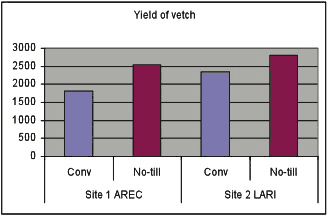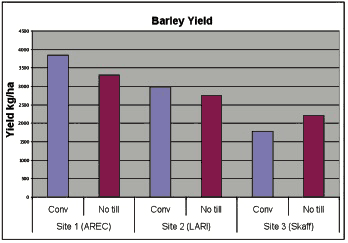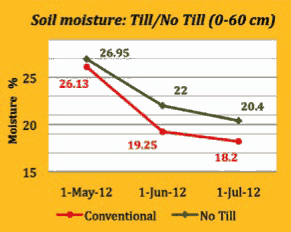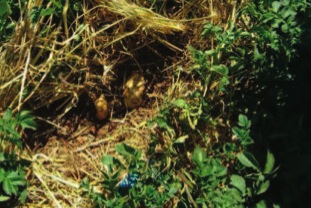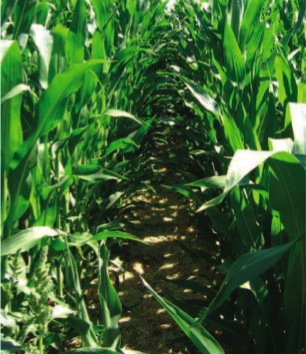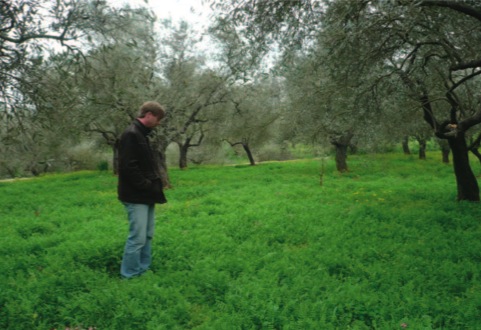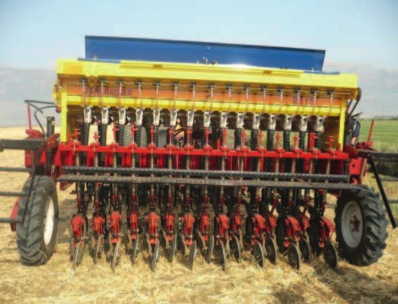Conservation Agriculture - Example: Experiences from Practicing Conservation Agriculture in Lebanon
 |
Background on ACSAD and GIZ
ACSAD-GIZ Cooperation Project on CA in LebanonThe German technical cooperation (GIZ) jointly with ACSAD undertook joint Conservation Agriculture (CA) projects in Lebanon. The objective is the promotion of conservation agriculture in Lebanon, in collaboration with the American University of Beirut (AUB), the Ministry of Agriculture represented by the Lebanese Agriculture Research Institute (LARI) in Tel-Amara, Bekaa, and farmers; and with the involvement of farm service providers and input suppliers.
Impact of CA on Crop YieldsIn the first season growing barley and vetch conventionally (CV) and directly through Conservation Agriculture - CA were compared at three locations. While in the first season (2007/8) barley yields of CV plots were higher than the yield of CA plots at AREC farm and LARI, yields of CA vetch was significantly higher than the yield of CV vetch (AREC 2550 compared to 1826kg/ha; at LARI 2810 compared to 2340 kg/ha) respectively (Figure 1) Figure 1: Yield of vetch at AREC and LARI (2008/09)
Only on the Skaff farm in Ammik barley yielded more under CA than under conventional production. However, the difference in yield was not significant (720 compared to 693 kg/ha) In the 2nd season 2008/9 yields trends were similar. Barley yields were lower under CA compared to CV, while vetch produced more. Best results were obtained with a mixture of barley and vetch, which produced 32% more biomass at AREC (45 versus 34t/ha). Reasons for the lower barley yield may be due to the high weed infestation in the early season. However the expectation is that yields will increase with the years under CA, due to improved soil quality. Figure 2: Yield of Barley at AREC, LARI, and Skaff farm (2008/09)
Impact of CA on Soil MoistureStopping ploughing and planting directly through soil cover reduces losses through evaporation of precious rain or irrigation water. In the first year the soil moisture content was slightly higher under CA, and it is expected to further increase with the years. Increases at harvest were significant, at a depth of 0-60 cm. This is an important aspect for subsequent summer crops. Figure 3: Change in Soil moisture levels at Skaff Farm, Ammik at a depth of 0-60 cm (summer 2008)
Impact of CA on weed infestation and controlThe data of the first two years indicated that, with time and under good management weed infestation goes down in the CA cultivated fields and becomes less than the infestation in the conventionally cultivated fields. Weed population also changes, depending on the crop rotation. After two years of applying CA at AREC, it was found that weed infestation in a barley-vetch field was significantly lower under CA system than under CV. Table 1: Change in Soil moisture levels at Skaff Farm, Ammik at a depth of 0-60 cm (summer 2008)
Impact of CA on Biological Activities (Earthworms)Earth worms are a good indicator of soil life. A living soil is a precondition for high productivity. The number of earthworms increased at AREC within only two years after the introduction of CA, from 1 to 5.7 earthworms/m2. Similar results were obtained on the Skaff farm in Ammik, which is a good indicator for improved aeration and fertility of the soil. A high biological activity helps to improve the soil structure. Earthworms help decomposing plant residues in soil (verticompost), increase organic matter in soil, and produce macropores, which improves water infiltration and aeration. Table 2: Number of Earthworms at AREC (April 2009)
Economical Advantages of CAThe reduction of production costs is the most attractive advantage of CA for farmers. Production costs are reduced from the first season on, especially costs of fuel, seeds and labour. By using a precision drill, seed quantities were reduced substantially, in some cases up to 30%. Additional costs for herbicide application may arise in some cases, when fields are heavily infested with weeds. Cost of production of field crops was about $ 350/ha less in CA than in conventional agriculture. As crop yields are in most cases equal or slightly higher, farmers will obtain higher net revenues when applying CA (40 $/Dunum for barley and 56 $/Dunum for barley-vetch mixture). Table 3: CA gives higher net returns for barley and for barley-vetch mixture
CA and Summer CropsIrrigated summer crops like maize for silage, potatoes or vegetables are part of the crop rotation in the Bekaa. Trials with direct planting of maize and drip irrigation, at AREC and Ammik, are very promising. Water use can be reduced by approximately 60 % when drip irrigation is applied, compared to sprinkler irrigation. Drip irrigation produces a homogenous maize field with lower weed infestation and higher yield. At AREC a first experiment with potatoes under No-till (CA) system was planted in 2009, with good results. For large scale application the results of the trials need to be further developed. Table 4: Increased net revenue with CA and Drip irrigation in maize ($/Dunum)
Photo 1: CA as an option for potatoes – Promising results were obtained with drip irrigation
Photo 2: CA and drip irrigation gives higher net returns despite increased production costs
CA under Olive PlantationsFarmers traditionally till the soil of orchards once or twice per year to minimise competition for water by weeds. However this practice is not only costly but also favours soil erosion and risks injury of the tree roots in top soil layer thus reducing root activities and favouring root infection by fungal diseases. Lebanese farmers see the need for a change in managing olive plantations. In the north-western part of Lebanon, Akkar and Khoura, some trials under olive trees were undertaken using clover, vetch and clover/vetch mixture as cover crops to protect the soil and at the same time to improve the soil properties. The first years results were very promising and the farmers proved keen to extend the trial over a large area of plantations.
Photo 3: CA under olive plantations
Adoption and Dissemination of CAThere is an increased interest in CA by all stakeholders of the agricultural sector in Lebanon. The number of farmers wanting to change to CA is growing. Farmers who are already practicing CA more than doubled the acreage in 2009/2010 to 11.000 Dunum.
Photo 4: A Brazilian Fankhauser Direct Drill
|
 |
OutlookWith the positive results and especially with the economic benefits of CA being visible to the farmers, CA will continue to grow in Lebanon and will be more and more accepted as a way towards sustainable agriculture and environmental protection. There will still be a need for continued practical and farmers need regular provision of information, good extension services, qualified extension officers, access to farm services, including appropriate machinery. Finally, the market in Lebanon also has to continue to remain conducive for CA agricultural practices to continue growing and expanding (including agricultural and market policies). |
